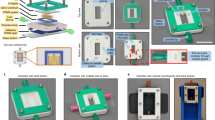Abstract
In this report, we focus on the microfabrication and cell seeding issues of artificial blood capillaries for tissue engineering. Two different fabrication methods (stainless steel electroforming and silicon electroforming) and a number of materials (PC, Polycarbonate and biocompatible material PLGA, poly lactide-co-glycolides) are implemented to build the vascular network. The vascular network is then used as the scaffold to cultivate the bovine endothelial cell (BEC). During the period of cell cultivation, oxygen and nutrient need to be continuously delivered by a circular pressurizing system. In cell culture, encouraging results are obtained through the dynamical seeding of the BEC on the scaffolds. A systematic cell culture process has been developed after repeated experiments. Successful seeding efficiencies are obtained by using the developed systematic cell culture process.


















Similar content being viewed by others
References
Alvarez M, Calle A, Tamayo J, Lechuga LM, Abad A, Montoya A (2003) Development of nanomechanical biosensors for detection of the pesticide DDT. Biosens Bioelectron 18:649–653
Becker H, Heim U (1999) Silicon as tool material for polymer hot embossing. In: Twelfth IEEE international conference on MEMS, pp 228–231
Borenstein JT, Terai H, King KR, Weinberg EJ, Kaazempur-Mofrad MR, Vacanti JP (2002) Microfabrication technology for vascularized tissue engineering. Biomed Microdev 4(3):167–175
Chang HK, Kim YK (2000) UV-LIGA process for high aspect ratio structure using stress barrier and C-shaped etch hole. Sens Actuat 84(3):342–350
Chang W, Trebotich D, Lee LP, Liepmann D (2000) Blood Flow in Simple Microchannels. In: Proceeding of the first annual international IEEE-EMBS special topic conference on microtechnologies in medicine and Biology, pp 311–315
Hui AP, Qin SJ (2002) High aspect ratio nano fluidic channels by laser controlled fracturing. In: Proceeding of the fifteenth IEEE international conference on MEMS, pp 156–159
Jeon NL, Chiu DT (2002) Design and fabrication of integrated passive valves and pumps for flexible polymer 3-Dimensional microfluidic systems. Biomed Microdev 4(2):117–121
Jiang G, Attiya S, Ocvirk G, Lee WE, Harrison DJ (2000) Red diode laser induced fluorescence diction with a confocal microscope on a microchip for capillary electrophoresis. Biosens Bioelectron 14:861–869
Kancharla VV, Chen S (2002) Fabrication of biodegradable polymeric micro-devices using laser micromachining. Biomed Microdev 4(2):105–109
King KR, Wang C, Weinberg E, Vacanti JP Borenstein JT (2002) Biodegrable polymer microfludics for tissue engineering microvasculature. MRS Symposium, MEMS and BioMEMS, San Francisco, April, 2002
Kovacs GTA, Maluf NI, Petersen KE (1998) Bulk micromachining of silicon. Proc IEEE 86(8):1536–1551
Madou MJ, Lee LJ, Daunert S, Lai S, Shih CH (2001) Design and fabrication of CD-like microfluidic platforms for diagnostics: microfluidic functions. Biomed Microdev 3(3):245–254
Marques C, Desta YM, Rogers J, Murphy MC, Kelly K (1997) Fabrication of high-aspect-ratio microstructures on planar and nonplanar surfaces using a modified LIGA process. J Microelectromech Syst 6(4):229–236
Martin RS, Gawron AJ, Lunte SM, Henry CS (2000) Dual-electrode electrochemical detection for poly (dimethylsiloxane)-fabricated capillary electrophoresis microchips. Anal Chem 72:3196–3202
Pan LC, Liang YC, Tseng FG, Leou KC, Chen LD, Lai YY (2002) A novel application of acoustic plate mode sensor in tissue regeneration. In: Proceedings of the IEEE-EMBS special topic conference on microtechnologies in medicine and biology:143–144
Polla DL, Krulevitch P, Wang A, Smith G, Diaz J, Mantell S, Zhou J, Zurn S, Nam Y, Cao L, Hamilton J, Fuller C, Gascoyne P (2000) MEMS-based diagnostic microsystems. In: Proceeding of the first annual international IEEE-EMBS special topic conference on microtechnologies in medicine and biology pp 41–44
Tang H, Beebe DJ (2003) Design and microfabrication of a flexible oral electrotactile display. J Microelectromech Syst 12(1):29–36
Acknowledgements
The authors would like to address their gratitude to the National Science Council of Taiwan for financial support under grant NSC-91-2212-E-005-012. The work was conducted in the Center of Tissue Engineering and Stem Cells Research (TESC) at the National Chung-Hsing University, Taiwan. The center is funded by National Health Research Institutes (NHRI).
Author information
Authors and Affiliations
Corresponding author
Rights and permissions
About this article
Cite this article
Wang, G.J., Chen, C.L., Hsu, S.H. et al. Bio-MEMS fabricated artificial capillaries for tissue engineering. Microsyst Technol 12, 120–127 (2005). https://doi.org/10.1007/s00542-005-0017-7
Received:
Accepted:
Published:
Issue Date:
DOI: https://doi.org/10.1007/s00542-005-0017-7




